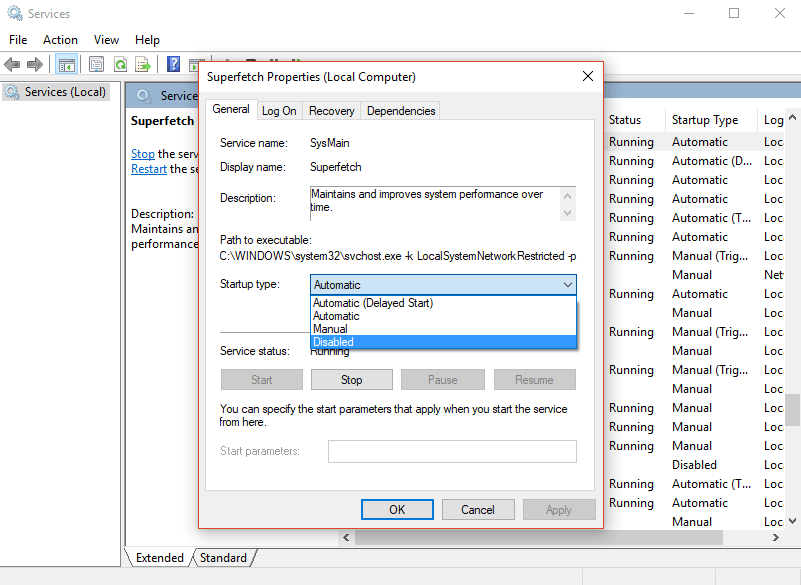In Windows Vista and onward all Windows OS, comes along with better support for modern hardware, in the form of SuperFetch. It is a technology that is meant for managing the amount of random access memory in a particular machine in order to enhance its efficiency. It’s a less capable version of PreFetcher, which was at first introduced through Windows Vista. It underwent changes to become a part of Windows’ memory manager and now has become the latest SuperFetch.
This new technology performs the task to ensure that the more than often accessible data can be read from the fast RAM instead of the slow hard drive. It serves two goals; to decrease boot time and to interact with the defragmenter, to make applications launch faster. Overall it ensures that it does not impact the system negatively.

However, the other side of the coin is that as it is time-consuming and so needs time for adapting to any kind of usage pattern. It runs at a low priority so one may abruptly note technical glitches while it is trying to manage the random memory. In this article, you will get a vivid insight into the issues and how you can revert the unwanted Service Host Superfetch error.
What Is Service Host Superfetch Issue?
Before proceeding to the solutions, you have to understand the underlying issue. This innovative technology, Service Host SuperFetch can improve the hard drive performance. But sometimes it can be the root cause of slowing down while accessing along with an SSD. Primarily, it is like a drive caching act which copies all your regularly managed files to RAM. If your system is not integrated with the advanced hardware, then Service Host Superfetch can be the cause behind high disk usage.
Furthermore, if you are working in a profoundly optimized system or in case the system has remarkably weak hardware, then it creates slowdowns. This is what you need to bypass. One needs to go through a well-organized procedure to recure this error since SuperFetch is always streaming in the background. It utilizes most of the system sources like CPU and RAM.
Service Host Superfetch high disk usage is rarely reported to be a dangerous sign. But it needs immediate action as this service makes maximum capability to respond to I/O requests. When this hosting service starts filling up the RAM with frequently used files, the size of these files increases over time. This is when it becomes a problem as it can take longer to sort out memory.
How Does Service Host SuperFetch Go Wrong?
If you are wondering what are the probable causes that can lead to the malfunctioning of SuperFetch then take a glance at the list mentioned below.
- Especially during gaming sessions, it causes a spike in the hard drive and CPU usage.
- If you are operating through systems with less than 4GB of RAM, then the function of SuperFetch faces a limitation.
- If periodical gameplay stutters do not get a solution, then it eventually shuffles around in memory, causing an error in the SuperFetch.
- While one boots Windows the hard drive is often overpowered to load an array of applications all at the same time. An error occurs as Windows does not get the time to load all the requisite apps and services.
- Often, issues associated with high HDD usage, degraded performance or high RAM usage, throughout heavy activities in RAM.
Now, that you are well acquainted with the highlighted facts, try to avoid them in the future, to prevent SuperFetch from occasional awry.
Also Read:- DNS Server Not Responding Error In Windows Device
Spotting The service
If you want to check, what effect SuperFetch brings to your system, then you can easily work your way out of it or avoid that source in the first place. However, you might find it even more difficult to spot the service when you first pull up the Task Manager. This is because, the sole purpose of this program is to allow Windows OS to maintain your regular apps and prevent abrupt crashing, and it does not even get listed in the process. It is difficult to monitor its work but when it creates technical glitches you can clearly feel it. However, if you still want to get to the process then, you have to look under the collection of generic “Service Host.” Scrolling through an exhaustive list of Service Host processes, you can get to ‘Service Host: Superfetch.’
How To Disable Service Host SuperFetch?
If you note that Service Host Superfetch is the reason behind high disk usage, then the only solution is to disable it. If you are worried that disabling this service will interrupt with the efficient functioning of your system, then that is a myth.

At first, you may feel some lagging issues while trying to access the commonly-used apps. But it won’t cause any system instability. In the next section, you get to secure it with easily applicable methods by disabling SuperFetch. All you need to do is follow the instructions carefully, in case you are not much acquainted with the technical domain. After the issue gets an appropriate solution, you can easily enable this feature to load the applications at a faster click-through rate.
You can either try to disable it from the service or through the Windows registry. These two methods can really help to get rid of the service host superfetch from your system.
Disable SuperFetch In Windows Services
You can use the SuperFetch Service application to disable. To initiate, you need to launch the application by navigating to the Start menu and in the search dialog box, type in ‘services.’ Hit the Enter key and from the search result click on the Services app.
Also Read:- Excellent Hacks For Resolving Windows Programs Errors
You can also launch the Service application through the Run prompt. All you need to do is simultaneously press down the Windows key and the R key. The Run dialog appears, type in ‘services.msc’ and click on the Ok button. A list of services will appears in a new window, scroll down and get to ‘Superfetch’. Right-click on it and from the drop-down list click on the ‘Stop’ option. You will note that the SuperFetch is now disabled securely.
Furthermore, you need to ensure that the SuperFetch does not start running automatically. Navigate to the Services app and right-click on the Superfetch tab. Go to the Properties tab and click on it. Look for the Startup type, under the General tab and change it from Enabled to Disable. You can again manually revert the changes and turn it on again.
Finally, get back to the Task Manager and verify whether your recent disk usage is representing a normal usage report or not.
Disable SuperFetch In The Registry
Disabling SuperFetch with the Services app is generally the most preferred method. However, if it does not work for you then you can make the necessary changes by editing the registry key directly.
To initiate the disabling process, you have to open the Registry Editor.
Go to the Start Menu and in the search bar type ‘regedit’ and hit the Enter key. From the search results click on the Registry editor file. Alternatively, you can also go to the Registry Editor, through the Run prompt. Just press down the Windows key as well as the R key, when the Run dialog box appears, type in ‘regedit’ and click on the OK button.

Now, you have to locate the SuperFetch key. All you need to do is navigate to the location ‘SYSTEM > CurrentControlSet > Control > Session Manager > MemoryManagement > PrefetchParameters’. On the right panel, you will be able to see the option Enable Superfetch. Right-click on it and click on the Modify option. This will bring up the key editor. Finally, disable SuperFetch, by changing the value data value to 0. When all the changes are complete, hit the Ok button.
After you are done, check the Task manager and note if you are able to view the service or not. These two steps must be enough to help you mitigate the problem within a flicker of time.
Conclusion
If you are operating through a computer with average specs, then with SuperFetch most you won’t even notice the flaws of your system. Disabling the SuperFetch program is only reliable while resolving the current ongoing problem or in case of potential threats. If even after disabling it, you are unable to retrieve the original performance of your system, then turn it back on. If you opt to resolve the problem, using the Registry Editor is a more than easy pathway. Additionally, you must have a backup of the Registry. In case, something goes wrong while disabling the problem, then you can easily restore the backup. This will get things back on the right track. Besides these, if you are not enough capable of carrying out the process all by yourself then do not hesitate to get the requisite technical help.

